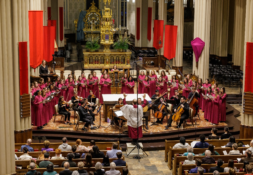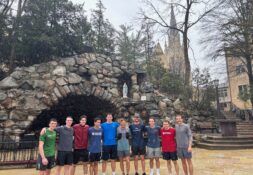In a “Beauty for Truth’s Sake” sponsored by the Notre Dame Center for Liturgy, Stratford Caldecott stressed the need to focus on beauty in order to find truth. Caldecott is the editor of Second Spring, a British journal of faith and culture.
The lecture, which was loosely based on Caldecott’s book of the same name, explored the relationship between beauty and truth and what that relationship means for Catholic education. Caldecott said, “We desire the truth because in some sense it is beautiful.”
He admitted that some truths are ugly on the surface, citing the movie THE MATRIX, in which the characters are not actually living the lives they think they are living. Yet somehow, he said, the truth is “more beautiful . . . than any lie or illusion, even if we cannot see it at once.”
According to Caldecott, beauty is one of the four traditional transcendentals, along with unity, truth, and goodness, all of which tell us about God because they come from Him. The experience of beauty, he said, “liberates us” from ourselves and parallels the experience of God. The ability “to rejoice in one who is not the self is the privilege of one who stands apart” and is self-conscious, he said. Without rejoicing at beauty, we are not living fully human lives.
Although joy does not traditionally count as a transcendental, it nevertheless is transcendent, Caldecott said. He quoted Hans Urs von Balthasar, who said that a baby first experiences joy when he smiles at his mother and she smiles back. In that instant, Balthasar said, the baby recognizes through his joy that being is one, good, beautiful, and true.
The ability to recognize this and other truths about the nature of things, Caldecott pointed out, is intricately tied up with humanity. Without this “metaphysical sense,” he said, things seem to be related only mechanically, but with it, they are transparent, showing the truth that lies behind them. Referring to Pope John Paul II’s encyclical FIDES ET RATIO, Caldecott said, “The rebirth of metaphysics goes hand in hand with the rebirth” of the culture of love.
The joy we experience at beauty, however, is not perfect. Caldecott cited both Tolkien and Lewis as writers whose concepts of joy were linked to experiencing God’s depth. Lewis said that this joy involved a kind of sadness. Tolkien’s elves of Middle Earth, although they are “steeped in joy” are also filled with “sorrow at living in a world of time, themselves unchanging,” Caldecott said. This is because they, and we, realize that our respective worlds are not perfect.
Wisdom, Caldecott said, is God’s original idea of the world, and also the idea of the saved world. “Nothing is perfectly itself until it [agrees] with God’s thought of it,” he stated. Moreover, if the “beauty of wisdom” draws man to his final end, then it is no exaggeration to say that wisdom is the “hidden life-energy of education.”
With wisdom, the seven traditional liberal arts can expand without losing their unity. Caldecott warned, however, against the danger of permitting the liberal arts to dissolve into the “arts of liberality. . . . Remember, it is not just beauty that is at stake here, but also” unity, goodness, and truth. Whoever relegates beauty to the past “will find himself unable to pray, and soon, unable to love.”
In order to guard against this danger, Caldecott said, a “sense of sacred order” must be protected by teachers and parents. Philosophical arguments for beauty, unity, goodness, and truth are good, but education must start much earlier by providing an environment conducive to metaphysical thought.
According to Caldecott, numbers and words are not arbitrary. Rather, they should be seen as attempts to identify the LOGOS, the cosmic order, of the universe.
“Poetry is the purest form of speech because it is the most pregnant with meaning, and song or music is perhaps purer than speech,” Caldecott said. Music, poetry, math, and the relationships between them guide us to the LOGOS.
What constitutes a good education? According to Caldecott, a good education teaches the part in the context of the whole. In the present day, education has been fragmented and the “sense of unity” has been lost. “Within each discipline,” he said, “there is a point of unity with the whole. It’s not that you need to artificially force things together. You just have to go deeper.”
Teresa Anne Gorman is a freshman who hasn’t decided on her major, except that she knows it will be something dorky. Though she planned todress up as Plato for Halloween, she ultimately canceled her celebration plans in favor of getting ahead on her homework. If that description hasn’t scared you off, you can get in touch with her at tgorman2@nd.edu.





